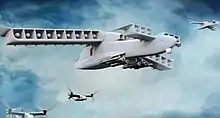Aurora Flight Sciences
Aurora Flight Sciences is an American aviation and aeronautics research subsidiary of Boeing which primarily specializes in the design and construction of special-purpose Unmanned aerial vehicles. Aurora has been established for 20+ years and their headquarters is at the Manassas Regional Airport in Manassas, Virginia.
 | |
.jpg.webp) NASA / Aurora D8 airliner concept | |
| Industry | Aerospace manufacturer |
|---|---|
| Founded | 1989 |
| Founder | John S. Langford III |
| Headquarters | , |
Number of locations | 4 |
Key people | Per Beith, President and CEO |
| Products | Unmanned aerial vehicles |
Number of employees | 468[1] |
| Parent | Boeing |
| Website | https://www.aurora.aero |
History
In 1989, the company was founded in Alexandria, Virginia, as a follow on to the MIT Daedalus project.
In 1991, its first aircraft was the Perseus proof of concept (POC) built for NASA which first flew at NASA Dryden. It was followed by two Perseus As and one Perseus B which were all built for the NASA ERAST Program. A twin engine Theseus was also built.
In 1995, Aurora joined the Global Hawk team and continues to build composite fuselage components and tail assemblies of the RQ-4 for Northrop Grumman and the USAF.
In 2002, a demonstration aircraft was flown from an altitude of 100,000 feet to simulate the low density of the martian atmosphere. Aurora has been involved in several NASA programs studying how to fly an aircraft on the planet Mars.
In 2008, the DARPA Vulture aimed for an UAV that could stay aloft for at least five years in the stratosphere, carrying a 1,000 lb (450 kg) payload: Aurora proposed three drones taking off separately then joining up in flight, to form an efficient flat wing at night, and folding into a Z for the best solar energy collection in daylight.[2]
In 2009, as Aurora has developed its own line of small vertical take-off UAVs known as the Aurora Goldeneye, the third variant of this family, the GoldenEye-80, was first flown publicly at Association for Unmanned Vehicle Systems International's Unmanned Systems North America trade show.
On 5 October 2017, Boeing announced that it would be acquiring Aurora Flight Sciences.[3]
In April 2018, as DARPA allowed Aurora to transition government-funded technology for commercial applications, the tilt-wing XV-24A Lightning Strike and its distributed propulsion could be reused for an electric commercial air taxi along its lift-and-cruise prototype with vertical flight rotors and cruise fixed propellers, unveiled in 2017. Aurora plans multiple demonstrators controlled centrally by 2020 and a piloted air taxi by 2023 with autonomy later depending on regulation.[4]
In spring 2019, Aurora plans to fly a High-Altitude Long Endurance drone powered by solar cells and batteries, Odysseus.
Facilities
Aurora has four facilities that each have their own focus. Corporate Headquarters and Engineering are in Manassas, Virginia. A manufacturing center was opened in Fairmont, West Virginia in 1994, being moved to Bridgeport, West Virginia in 2000. Another manufacturing facility was opened in Starkville, Mississippi in 2005 before being moved to the nearby Golden Triangle Regional Airport in Columbus, Mississippi in 2007. A research and development center was opened in Cambridge, Massachusetts in 2005 where Aurora now develops a line of micro air vehicles.
Aircraft produced

- Perseus POC
- Perseus A
- Theseus
- Perseus B
- Chiron
- MarsFlyer[5]
- GoldenEye 100
- GoldenEye 50[6]
- GoldenEye 80[7]
- Excalibur[8]
- Centaur Optionally-Piloted Aircraft (OPA)
- Orion
- SunLight Eagle
- Odysseus
- Skate SUAS
- Tactical Autonomous Aerial Logistics System (TALOS)
Proposed aircraft
- United States Air Force Advanced Composite Cargo Aircraft (ACCA) - lost out to Lockheed Martin X-55.
- Aurora D8 for NASA by the Massachusetts Institute of Technology - currently under development. A flight test will be conducted by 2021.[9]
- The Aurora XV-24 LightningStrike was the selected proposal for the VTOL X-Plane program, cancelled in April 2018.
Other products
- Robotic Copilot[10]
References
- "AURORA FLIGHT SCIENCES CORPORATION". sbir.gov. Retrieved 2 April 2017.
 This article incorporates text from this source, which is in the public domain.
This article incorporates text from this source, which is in the public domain. - Graham Warwick (14 November 2018). "This Is Aurora's Massive Solar-Powered Stratospheric Unmanned Aircraft". Aviation Week & Space Technology.
- Alwyn Scott (5 October 2017). "Boeing to buy autonomous and electric flight firm Aurora". Reuters.
- Stephen Trimble (25 April 2018). "DARPA approval clears Boeing's transition to new air taxi approach". Flightglobal.
- "ARES Mars Scout Mission Proposal - Platform". Marsairplane.larc.nasa.gov. NASA. Archived from the original on 12 December 2013. Retrieved 26 December 2013.
 This article incorporates text from this source, which is in the public domain.
This article incorporates text from this source, which is in the public domain. - "GoldenEye 50 Gets Airworthiness Certificate", Aerospace Daily & Defense Report, June 19, 2007. Retrieved on August 25, 2009.
- "Morris, Jefferson: GoldenEye 80 UAV Gearing Up For Second Flight", AviationWeek.com, December 7, 2006. Retrieved on August 25, 2009.
- Hovering Hybrid, page 36. Aviation Week & Space Technology, July 20, 2009.
- Graham Warwick (18 January 2017). "Aurora Refines Design Of Ultraefficient D8 Airliner". Aviation Week & Space Technology.
- https://www.aurora.aero/robotic_copilot/ Robotic Copilot
.svg.png.webp)